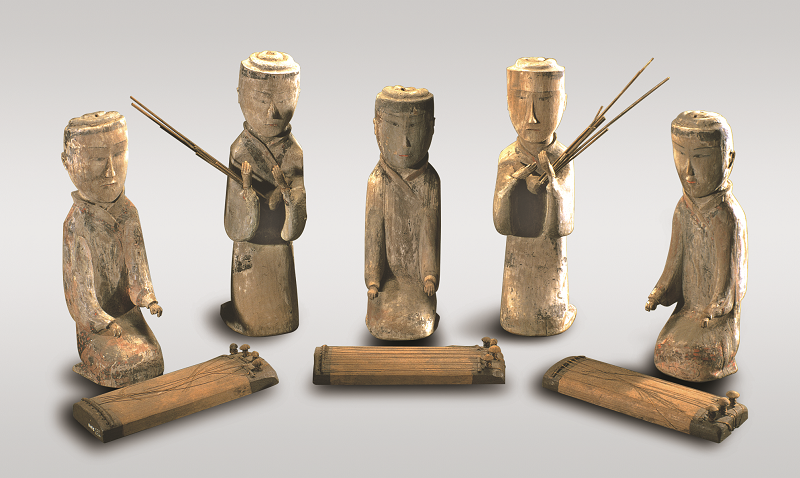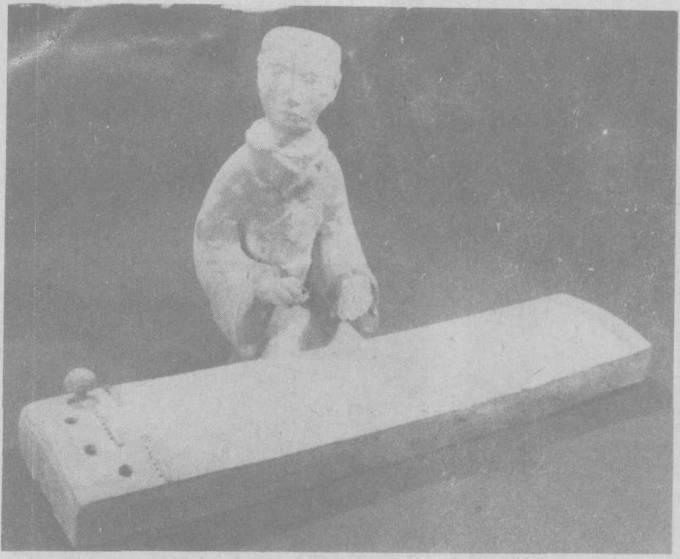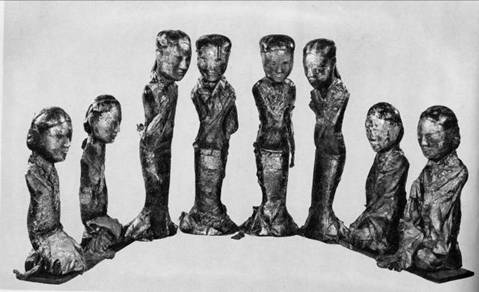Wooden Figurines of Musicians in the Western Han Dynasty

Western Han Dynasty
Excavated in 1972 from Mawangdui No. 1 Han tomb, Changsha, Hunan Province.
Heights: 32.5cm-38cm
This set of ‘band’ figurines unearthed from the No.1 Han tombs consists of five figurines of musicians, among them two play Yu (an ancient Chinese wind instrument) and the other three play the Se (an ancient Chinese string instrument). The figurines were delicately carved in full relief and painted: they have low foreheads, high noses, black eyebrows (painted in ink) and red lips (painted in cinnabar). Wearing typical colored Han Chinese robes, the five figurines sit in a kneeling position with bamboo sticks inserted in top of their heads, distinguishing them from the group figurines also unearthed from the Mawangdui Han tombs. This group of figurines vividly reproduces the luxurious and merry life of the tomb owners when they were alive, which is valuable historical material for contemporary people to learn the lifestyles, costumes, and funeral customs of the nobles during early Han Dynasty.
深入探索
Figurines of musicians and dancers
In ancient China, figurines were made to accompany the dead, taking the place of people buried alive, which reflected the social progress of Chinese civilization. Figurine materials evolved from the earliest thatch to later pottery, wood and stone. Coming into being during the pre-Qin period (21st century B.C. - 221 B.C.), the custom of burying with figurines prevailed and reached the highest artistic level in the Han and Tang Dynasties. From the Song and Yuan Dynasties, however, it became less popular.
Figurinzs of musicians and dancers vividly present scenes of performance by a single person or groups. As a general category, this type of figurines includes those singing, dancing, and doing burlesque.
Figurines of musicians and dancers were mostly discovered in large-scale tombs because the owners of those, usually in possession of enormous power and fortune, hoped that their rich and happy life could continue in the other world. In Han dynasty when a mature regulation system concerning nobles’ tombs hadn’t been established, there were many large tombs with abundant burial goods. According to archeological discoveries, three pottery figurines of men playing Se were excavated from Beidongshan Western Han tomb, two solid coppery figurines of people playing burlesque in the tomb of feudatory King Liusheng and his wife and a large number of musical instruments and figurines in the grave of the king of Lv State (a vassal state of Han dynasty, Shandong province.)

Pottery figurine of a man playing Se, excavated from Beidongshan Western Han tomb, Xuzhou, Jiangsu Province
Coppery figurines of people playing burlesque, excavated from Mancheng Han tomb, Baoding, Hebei Province.

Wooden figurines of singers and dancers, excavated from Mawangdui Han tombs.



